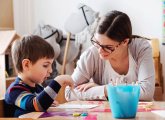Sarah Heale of charity What About the Children? looks into the crucial role secure attachment plays in children’s development and wellbeing…
After years in the wilderness attachment is back, but you’d be forgiven for thinking you’d imagined the whole thing after the government’s attitude towards adult:child ratios in recent years.
What About The Children? promotes the importance of secure attachment in the early years and the vital role that consistent, loving care plays in brain development.
The introduction of the revised EYFS framework in 2014 meant that some progress was made on attachment. The switch to the phrase ‘key person’ from ‘key worker’ put a greater focus on relationships.
Why is the relationship so important in a nursery setting? Isn’t that where mum and dad come in? After all, intimate relationships with other people’s children are complicated – not least because of child protection issues.
The term attachment is used to refer to the emotional relationships between a baby and the people who spend the most time caring for the baby. It provides the baby with a comforting sense of security and safety.
From six months onwards (peaking at around 12 months and tailing off between the ages of two and three) a baby exhibits attachment behaviours. They show a desire for closeness to the primary attachment figure (usually mum) in a variety of ways:
● following her with their eyes or moving themselves to be close, especially in new situations
● separation anxiety when the attachment figure is not present
● crying if she leaves
● excitement on her return
● clinging behaviour on her return as if they fear she will leave again
● fear of strangers
Of course, infants will form attachments to other caregivers who love them. Current thinking suggests that some relationships are more important than others, with the primary attachment figure at the top of the pyramid, then a couple of people in the next tier and a few more in the next, and so on.
The attachments will get weaker as you go down the pyramid. The infant will do better in their development with one or two strong attachment relationships rather than several weaker ones.
“Of course, infants will form attachments to other caregivers who love them”
In fact, research suggests children seem to do best when they have at least three adults who consistently send the message, ‘I care about you’.
Researchers theorise that spending time with non-parental caregivers – a grandparent, daycare teacher, family friend, doting aunt – helps infants learn to read different facial expressions and expand their ability to take the perspectives of others.
There is now little doubt that the first three years of life shape a human’s mental, emotional and physical health for life – and quite out of proportion to the later years of childhood.
The third birthday is a milestone, because brain development is about 90 per cent complete, speech is established and separation from the main carer becomes easier. New horizons open up: friendships can be formed, preschool education becomes relevant and independence is a new skill to try out.
We now know that it is consistent, loving care that enables all this to happen. It fires the links between brain cells (particularly in the emotional centre of the brain) which allow the brain to grow.
There are many ways synaptic links are fired, but in the first few years it is loving communication and attunement between child and carers that is key. The relationships that under-threes have with their carers are the key predictor of development – social, emotional and physical.
These are the four key features in ‘psychology speak’:
Affect synchrony: the carer’s ability to pick up cues from the infant and adapt her/his behaviour accordingly. For example, if the carer sees the baby is unhappy they’ll pick up the baby, speaking soothingly to them. It causes stress for the infant if the carer misreads the cues and becomes either too intrusive or too withdrawn. For example, a carer who persists in trying to engage a baby when they are obviously turning away or pulling away from them increases the child’s distress.
Mentalisation: the process of interacting with the infant as a sentient being with desires, intentions and thoughts – in addition to caring for the child’s physical needs. So a carer who sees a baby kicking his legs and making eye contact might say, “Do you want to play?” or “Are you ready for your bath?”
Mirroring: the carer’s skill in reflecting back to the infant an approximation for what her infant is feeling. Good carers tend to make exaggerated happy and sad faces at little ones, making them easier to imitate and building on the baby’s basic innate understanding of emotional communication.
Containment: the carer’s ability to take on a child’s overwhelming feelings and make them more manageable for the infant. The carer may use touch, speech or gesture to convey to the infant that they understand what they are going through.
“To make the message even plainer, it’s about love and consistency”
In layman’s terms that means…
● Spending considerable time each day one-to-one: talking, cuddling, making them laugh
● Calming an infant when they’re stressed – using eye-to-eye contact with gentle murmured conversation to soothe
● Over time, developing an understanding of their communication attempts and responding accordingly
And to make the message even plainer, it’s about love and consistency.
In a nutshell, carers have a great deal of influence over a child’s development and future wellbeing. Like the builder who says “I am building a cathedral” rather than “I am laying bricks”, so an early years practitioner should say “I am building our future society” rather than “I am changing nappies.”
Read Sarah’s article on the emotional challenges of implementing strong attachment.
Sarah Heale is a trustee of charity What About The Children?

Tips on supporting young children with SEND
Editors picks
